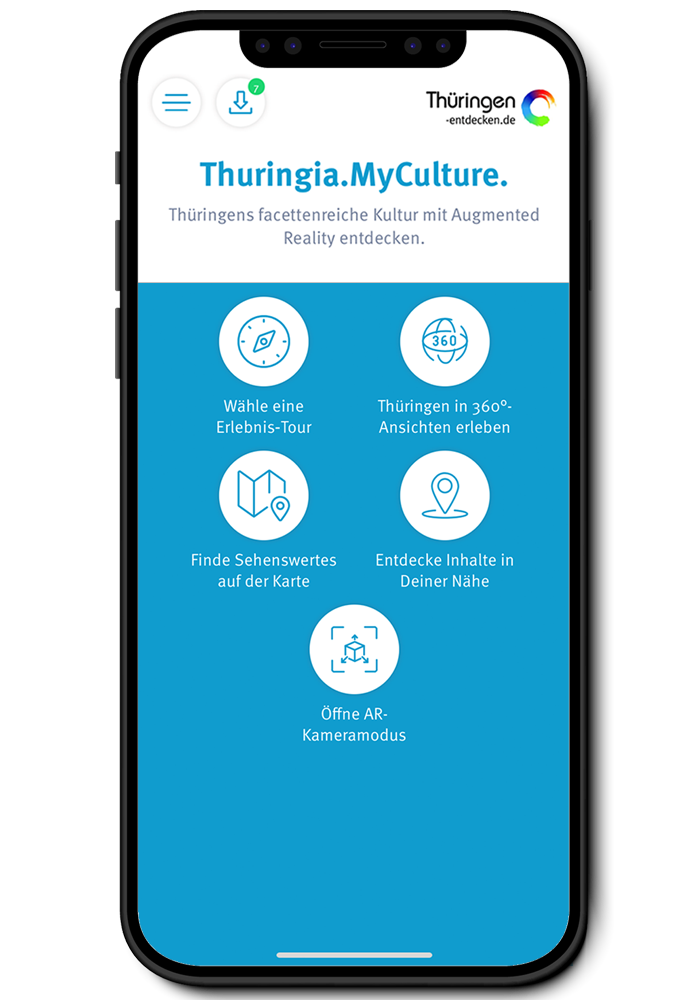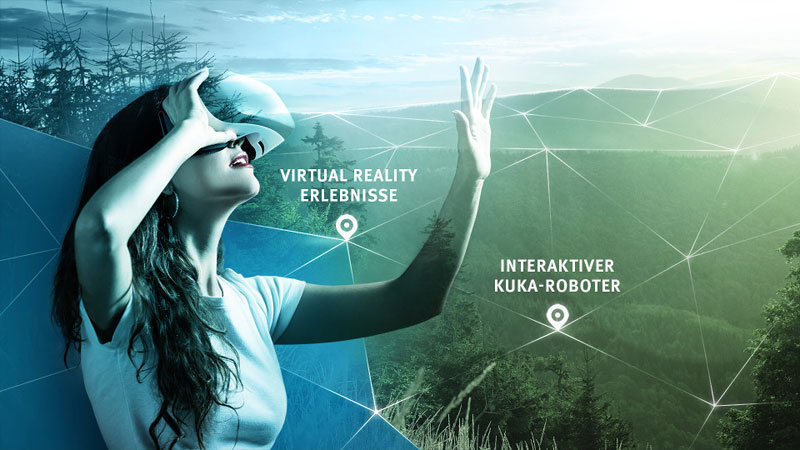Visit the state capital Erfurt and go on a virtual discovery tour through Thuringia.
Printing and design made in Thuringia
Bauhaus and blue printing
Just after the end of the First World War, there was, after all the upheavals, a great openness to new ideas and utopias, especially amongst young people. They asked themselves: how do we want to live in the future – in our everyday lives and as society? When Walter Gropius founded the Staatliches Bauhaus in Weimar in 1919, the art school therefore soon became a place for experimenting with architecture and design. There, people worked on an interdisciplinary level, initially often still by hand. In the new Bauhaus Museum in Weimar, visitors can admire many of the pieces created at that time, which have long since become design icons. Anyone who would like to experience Bauhaus architecture can walk through the Park an der Ilm to the Haus Am Horn. The bungalow was designed by Georg Muche in 1923 and is Weimar’s most important building in the New Objectivity style. It unfolds its charm on the inside: the fitted kitchen, the rooms that are all arranged around a central room with skylights, the colours, the light. It takes you back to the 1920s and you would love to move in straightaway because everything is so clear yet comfortable. For the 100th birthday of the Haus Am Horn, the foundation Klassik Stiftung Weimar dedicated its 2023 annual programme to the subject of living.
Experiments with typefaces and printing graphics
At that time, printing was not a subject at the Bauhaus, but with the help of hand-operated presses that came from the time of the old School of Art in Weimar, those who were interested learnt relief and intaglio printing and experimented with typefaces and graphics. As they were concerned with change, blue printing was hardly covered. Conversely, the woad experts in Erfurt are now interested in the art school’s design vocabulary once more.
Soft designer scarf
For example Rosanna Minelli has designed a “Blauhaus Collection” with woollen scarves. The painting restorer knows her way around colours and manages the small “Erfurter Blau” shop on the Krämerbrücke bridge. Minelli has devoted herself to blue dyeing, experiments with the dye made from the leaves of the woad plant (and other plants), provides workshops and sells products that she has designed herself: sky-coloured T-shirts, scarves in soft shades of blue, table runners and little trifles such as brooches or key rings. Rosanna Minelli says: “Every piece is as unique as the day on which it was created.”
A very special blue
“The Thuringian Basin has particularly good soil,” continues Minelli. That is why woad was grown there as early as the Middle Ages. The plant contributed to Erfurt’s wealth. Minelli has learnt the old techniques. She extracts colour pigments from the leaves of the plant by means of fermentation and drying, just like they did in the past. The expert also works with blue printing and other design techniques, of course, but is primarily interested in the history of the craft. Actual blue printing emerged later, from around 1700. In this process, models made of wood or brass are immersed in a sugar lift. The often floral patterns on these blocks are applied to the white fabric – the colour does not come through in the places where the “release agent” is. This is how traditional patterns are created that are reminiscent of the batik technique. In the Ethnographic Museum in Erfurt, you can see a number of historic pieces of linen.
Blue printing workshop
Kris Wezyk from the Dürerhaus in Erfurt has devoted himself to this historic and rustic blue printing in his workshop for more than 20 years. The jewellery designer and blue printing specialist has a collection of around 450 blocks – flowers, patterns and Bauhaus motifs that come from the 1920s – and produces scarves, tablecloths and runners in a woad or indigo dip. These can then be bought in the tradition-steeped Dürerhaus – a shop were many artisans from the region are able to offer their special pieces. The Dürerhaus also does blue printing tours and workshops. You can make you own favourite blue-printed item here: select the model and the material, mark the reference lines on the fabric. Then the blocks are immersed in the release agent under the instruction of Kris Wezyk and carefully set down on the material. Press and lift – and the subsequent white pattern appears quite delicately in grey on white. Now you just have to wait. The material is generally made, i.e. dyed, blue in the workshop later, when enough pieces have been gathered for dyeing.
Did you know?
This is how the material is dyed blue
You want to know and experience more?
klassik-stiftung.de
erfurterblau.de
duererhaus-erfurt.de
volkskundemuseum-erfurt.de
Did you like this story?
Maybe, you'll like this too ...















